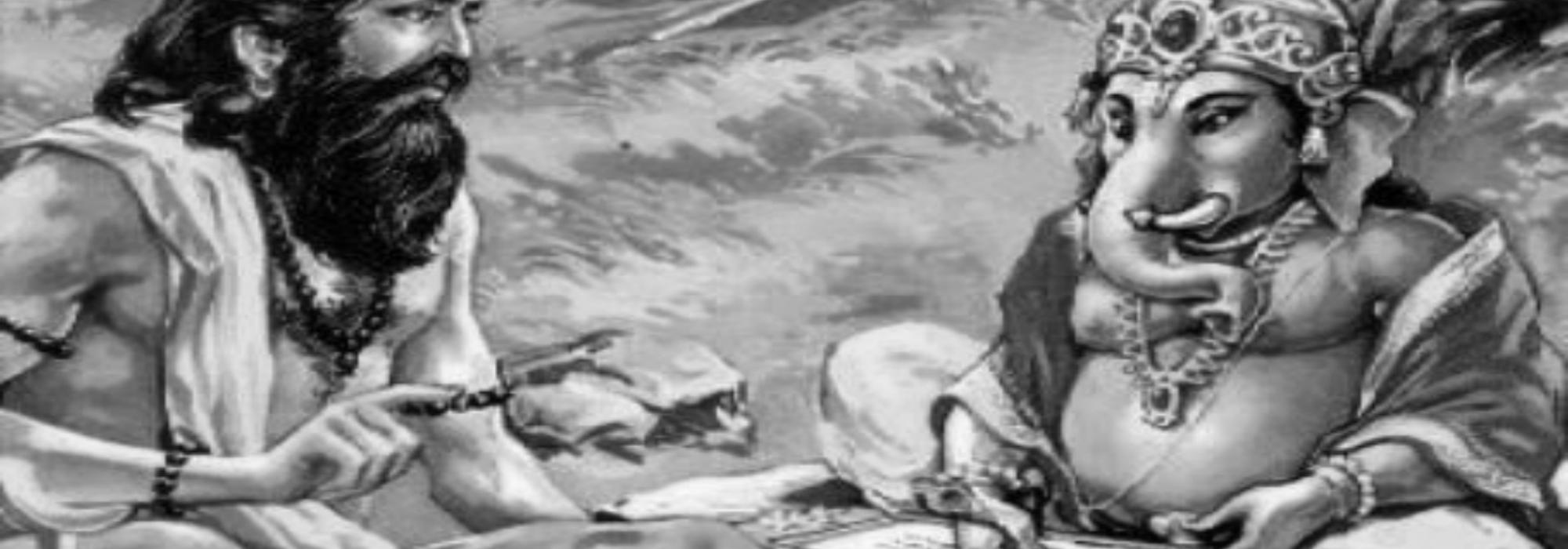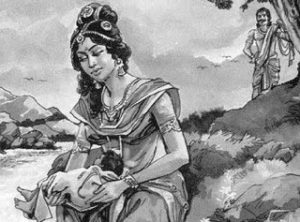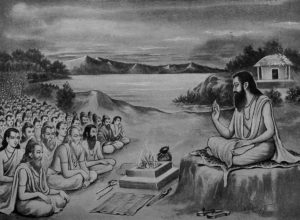Adhyāyas 62-88 – Śakuntalopākhyānam, Vaṃśanukrama, Yayātyupākhyānam (Śakuntalā’s story, details of the lineage and Yayāti’s story)
In these adhyāyas, Vaiśampāyana has chosen to narrate the sub-stories of Duṣyanta-Bhārata and Yayāti-Puru, perhaps because they are interesting and sizeable, or because they are about famous kings. Yayāti is an ancestor of Duṣyanta, separated by around eighteen generations; yet Duṣyanta’s story (adhyāyas 62-69) appears before his ancestor’s (adhyāyas 71-88). Before Yayāti’s story, there’s an adhyāya (70) dedicated to the description of the lineage starting from Dakṣa-Prajāpati until Yayāti. Perhaps with a view to fix the chronology, the Southern recensions have placed Yayāti’s story before Duṣyanta’s. This is not so in the critical text edited by V S Sukthankar.
Adhyāya 89 – Paura-vaṃśa (lineage of Purus)
The eighty-ninth adhyāya speaks about the growth of the Puru lineage starting from Puru until Śantanu.
Adhyāya 90 – Lineage from Brahma to Aśvamedha-datta
In the ninetieth adhyāya, the family tree expands to older ancestors as well as newer descendants, spanning kings starting from Dakṣa-brahma all the way until Aśvamedha-datta, the grandson of Janamejaya (the one who heard the Mahābhārata story from Vaiśampāyana). Leaving out the sub-branches, the main family tree is as follows: 1. Dakṣa, 2. Vivasvanta, 3. Manu, 4. Ilā, 5. Purūrava, 6. Āyu, 7. Nahuṣa, 8. Yayāti, 9. Pūru, 10. Janamejaya, 11. Prācinvanta, 12. Saṃyāti, 13. Ahampāti, 14. Sārvabhauma, 15. Jayatsena, 16. Arācīna, 17. Mahābhauma, 18. Āyutanāyī, 19. Akrodhana, 20. Devātithi, 21. Ṛca, 22. Ṛkṣa, 23. Matināra, 24. Taṃsu, 25. Ilina, 26. Duṣyanta, 27. Bharata, 28. Bhumanyu, 29. Suhotra, 30. Hastī, 31. Vikuṇṭhana, 32. Ajamīḍha, 33. Saṃvaraṇa, 34. Kuru, 35. Viḍūratha, 36. Arugvanta, 37. Parīkṣit, 38. Bhīmasena, 39. Paryaśrava (Pratīpa), 40. Śantanu, 41. (Bhīṣma and) Vicitravīrya, 42. (Dhṛtarāṣṭra, Vidura, and) Pāṇḍu, 43. Pāṇḍavas, 44. (from Arjuna) Abhīmanyu, 45. Parikṣit, 46. Janamejaya, 47. Śatānīka, and 48. Aśvamedha-datta.
It was Hastī who built Hastināpura, the capital city of the Kauravas. It is also known as Hastinagara, Hastināvati, and Gajapura.
Adhyāyas 91-92 – The Story of Śantanu and Bhīṣma; the Beginning of the Bhārata
In the ninety-first adhyāya, Vaiśampāyana begins his narration with the following verse:
इक्ष्वाकुवंशप्रभवो
राजासीत् पृथिवीपतिः ।
महाभिष इति ख्यातः
सत्यवाक् सत्यविक्रमः ॥
There lived a king,
from the Ikṣvāku clan,
famous as ‘Mahābhiṣa,’
known for his honesty and noble victories!
As soon as one reads this, one gets the impression that the story has begun. This however is merely the introduction to Śantanu’s reign. It tells us about his marriage to the divine Gaṅgā, the death of his children except Bhīṣma, and why Bhīṣma remained a brahmacāri (by giving a background story from his previous life). Here is the summary of twenty-three verses from adhyāyas 91-92:
A king, famous as Mahābhiṣa, born in the Ikṣvāku-vaṃśa, performed the Aśvamedha, Vājapeya, and other yāgas and attained svarga-loka. There, he once ogled at Gaṅgā whose sari had slipped due to a strong breeze, was therefore cursed by Brahma to be take birth as a human on earth. When Gaṅgā was preoccupied with thoughts about Mahābhiṣa, the eight Vasus happened to pass by. Seeing that they were all dejected, Gaṅgā asked them the reason. They told her that they had been cursed by Vasiṣṭha to be take birth as humans on earth; if she obliged, they could be born to her. They requested her to help end their human lives instantly so as to liberate them from the curse. She asked them who their father on earth would be and they named Śantanu. Gaṅgā gave her consent. [The Vasu named ‘Dhyauḥ,’ the main culprit, took birth as Bhīṣma and thus lived a longer life as compared to the other seven. It is typical to our Purāṇas to justify a strange or unique episode by creating a past life story that gives an explanation. Such stories abound in the Mahābhārata.]
Once Gaṅgā had fallen in love with the king Pratīpa, who did not reciprocate her love and instead, asked her to be his daughter-in-law. However, he didn’t have a son. Gaṅgā thus had to wait until he had a son and he grew up into a man. She waited and waited. Although Pratīpa was an old man, he begot a son through tapas (penance). Mahābhiṣa, who was cursed by Brahma, took birth as Pratīpa’s son. Since the child was born when Pratīpa was in a śānta (peaceful) state, the child was named Śantanu. [There is yet another explanation for this: यं यं कराभ्यां स्पृशति जीर्णं स सुखमश्नुते। पुनर्युवा च भवति तस्मात् शन्तनुं विदुः॥ (1.90.48) By the touch of his hands, even an old person attained comfort and youth; since peace (śaṃ) is caused (tanuḥ) by him, he was called ‘Śantanu.’] Once Śantanu was of age, Pratīpa got him married to Gaṅgā, coronated him, and took refuge in the forest. As Gaṅgā got married to Śantanu, the Vasus took birth as their children, and thus their request was fulfilled. [In the Harivaṃśa (adhyāya 53), there is a story about how Śantanu is an incarnation of the ocean. This was perhaps created to establish the pātivratya (chastity) of Gaṅgā! If he was the ocean, then he is her husband, not another – all the rivers have the ocean as their husband, after all!]
Origin and Development of Mahābhārata
The previous articles dealt with the introductory section of the Mahābhārata. This can be divided into three portions: 1. The section that starts with the verse Nārāyaṇaṃ namaskṛtya, 2. The section that starts with Ādyaṃ puruṣamīśānam, and 3. The section that starts with Gurave prāṅnamaskṛtya. The third section marks the entry of Vaiśampāyana in the epic. The words of the Sūta-Paurāṇika start off the second section. The first section is of unknown origin. Let us assume that it is that of an unknown Bhāgavata- Paurāṇika (traditional storyteller) since this seems to have been the mantra of several Bhāgavata traditions. It is almost certain that these sections were not composed by Vyāsa. Even in the epic narrated by Vaiśampāyana from start to end, it is difficult to distinguish which portion is Vyāsa’s and which is Vaiśampāyana’s. Vaiśampāyana had only heard the story when Vyāsa narrated it [‘यन्मत्तः श्रुतवानसि’ (1.54.22)]. We are unsure if Vyāsa narrated the story in prose or verse to Vaiśampāyana. The Sūta-Paurāṇika Ugraśrava at one instance says, “During the sarpa-yāga, all brāhmaṇas except Vyāsa narrated stories from the Vedas but Vyāsa always narrated the story of Bhārata alone.” Śaunaka then asked, “If so, please tell us the Bhārata story that you heard from Vyāsa.” Ugraśrava said, “So be it! I shall narrate the elaborate story of the epic Mahābhārata as retold by Kṛṣṇa-dvaipāyana. I too am eager to recount that very tale.” Saying so, he started the Bhārata epic.
However, in other places, we find that Vyāsa is not the one who narrates the epic at the sarpa-yāga, but it is his disciple, Vaiśampāyana. It is hard to reconcile these contradictions. It has been said in several places that Vyāsa
‘composed’ the epic. Whatever be the case, the original composer is Vyāsa. Perhaps it was Vaiśampāyana who first elaborated and retold Vyāsa’s composition. That was further elaborated and narrated by the Sūta-Paurāṇika. The later paurāṇika (story-tellers) have probably further elaborated the story. The variation in the total number of verses, i.e. 8,800; 24,000; and 1,00,000 also suggest this. One of the reasons for this expansion is that knowledge was transmitted by means of an oral tradition in India, and the paurāṇikas, while retelling the story of the epic, expanded it by narrating sub-stories and these were digested into the main composition. In summary, the extant Mahābhārata is only in Vaiśampāyana’s words. It doesn’t seem like he is reading out a work written or dictated by Vyāsa.
Vyāsa composed the Bhārata poem (कृतं मयेदं भगवन् काव्यं परमपूजितम्) in his mind (मनसा कल्पितस्य च) and was wondering how to convey this to his disciples. Then Brahma appeared in front of him and suggested that he get it written by Gaṇapati. This story appears in some versions of the Bhārata (V S Sukthankar considers this to be a later interpolation). It’s hard to say why Vyāsa did not write it himself, why he needed a scribe in Gaṇapati, and why Brahma made such a suggestion. It’s hard to say what skill Gaṇapati had in writing that the others lack. (In the invocatory verse to Gaṇapati, we have ‘कविं कवीनाम्’ but the popular commentaries consider this to be in praise of Brahma). According to this legend, Gaṇapati agreed to take the dictation under one condition: that Vyāsa should continuously recite the verses, never letting Gaṇapati put down his writing instrument [his broken tusk in this case]. Vyāsa agreed to this condition with a rule of his own, which was that Gaṇapati should comprehend the meaning of the verses that he was writing down. The story goes that Vyāsa was either creating the epic in his mind and hadn’t yet composed some verses in the ‘grantha’ form (containing 32 letters) or had to introspect out of his ‘kutūhala’ - ग्रन्थग्रन्थिं तदा चक्रे मुनिर्गूढं कुतूहलात्) ; during the times he had to compose the verses and re-create the episodes giving a fresh perspective or when his inquisitive mind was contemplating, he had to pause for a bit and to keep Gaṇapati engaged, he would dictate a complex verse. By the time Gaṇapati grasped its meaning and noted it down, Vyāsa would have got enough time to think and would then continue the dictation.
Although Gaṇapati is omniscient, it is said that there are 8,800 verses that took him a while to understand. The Sūta-Paurāṇika says that only Śuka and himself know the meaning of those verses and that he is unsure if even Sañjaya knows it. No one has pointed out which these verses are and none can even point out, probably. These 8,800 verses are hailed as Vyāsa’s secret, ‘vyāsa-ghaṭṭa’ and ‘kūṭaśloka’. To say that Vyāsa had to pause 8,800 times while dictating the epic and Gaṇapati sat pondering over the meaning does not go well with either of their brilliant minds. The number 8,800 probably signifies the original number of verses of the Mahābhārata. The number was traditionally retained, even as the epic grew in its size. Some think that such was the context for bringing in the number. (Note: It is hard to say who the Sañjaya referred to here is. Was Sañjaya, who narrated the Kurukṣetra war to Dhṛtarāṣtra, still alive during the sarpa-yāga of Janamejaya? There are only 23783 verses in the yuddha-pañcaka)
To put it in modern terminology, the epic-poem ‘Jaya’ composed by Vyāsa was compiled by Vaiśampāyana and he gave it the form ‘Bhārata’. Sauti (i.e., Sūta-Paurāṇika Ugraśrava) added the upodghāta section (prologue), index, footnotes and appendicies to make it the enlarged ‘Mahābhārata’.
Most Purāṇas start off like the Mahābhārata, i.e, Sūta-Paurāṇika Ugraśrava narrates the story to Śaunaka and others in the Naimiśāraṇya. This looks like an imitation of the pattern set in the Mahābhārata.
To be continued.
Thanks to Śatāvadhāni Dr. R Ganesh for his astute feedback.



















































